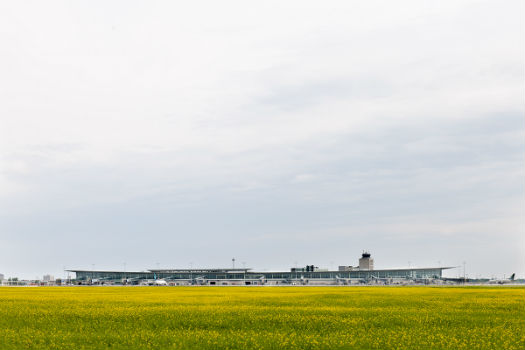Estimated reading time 5 minutes, 11 seconds.
The Winnipeg James Armstrong Richardson International Airport is the first Canadian airport to be LEED certified, making it one of only 24 airports worldwide to earn this certification. Laird Kay Photo
The Winnipeg James Armstrong Richardson International Airport (YWG) reached a major environmental landmark earlier this year, when it was recognized as the first airport terminal in Canada to become Leadership in Energy and Environmental Design (LEED) certified. This certification has only been awarded to 17 airports in North America, and just 24 worldwide.
“As the first Canadian airport to be LEED certified, we feel very proud, and because we’re the first, we feel like pioneers,” said Breanne Talbot, manager of communications and public affairs at the Winnipeg Airports Authority, during a recent interview with Skies. “It’s a great achievement for the team as a whole.”
LEED is an architectural rating system that provides third-party evaluations of a building’s environmental sustainability. To obtain LEED certification, a building must adhere to certain environmentally friendly practices to earn credits, which in turn will earn different levels of certification. The Winnipeg Airport terminal building achieved silver certification, a higher level than originally anticipated.
“It is our vision to lead transportation, innovation, and growth, and this project definitely supports that,” said Tara Hull, environmental coordinator for the Winnipeg Airports Authority. “We like to be front-runners in everything we do, and this is one of our greatest achievements.”
Becoming a LEED certified airport terminal is no easy task, so environmental planning had to begin while the building was still in its design phase. For example, one credit was earned by incorporating day lighting into the terminal. This is accomplished via an expansive glass wall, which allows solar rays to enter the building.
A large canopy at the end of the terminal building, along with sunshades and ceramic frits in the glass panes, work to reduce direct solar heat gain in the building. Laird Kay Photo
“The building is highly energy efficient,” said Hull. “We have included ventilation totems, jet diffusers, and radiant flooring that work in tandem to provide heating and cooling.”
In addition to easing the minds of environmentally conscious passengers, aircraft operators can feel better about using Winnipeg’s environmentally sound airport.
“We were able to develop a plan for airlines to reduce their aircraft auxiliary power unit (APU) time,” explained Hull. “We provided electric-powered, pre-conditioned air and 400Hz power supply at all gates, so that aircraft don’t have to run their APUs or use diesel-powered equipment. This helps to lower emissions at the airport.”
Other credits included in the Winnipeg Airport Authority’s LEED certification were earned through bus routes leading to the terminal, water efficient fixtures, and by using 15.5 per cent recycled construction materials and 11.69 per cent regionally manufactured materials during the build. Another significant credit was earned through the construction of a large green space east of the terminal’s parkade.
“We set aside a green space that’s greater than the footprint of the terminal building, and planted it with species that are native to Manitoba,” said Hull. “Because we selected drought resistant plants, we don’t need to irrigate beyond the establishment period.”
Hull also explained that by investing time and money into environmental components for the terminal building during its planning stages, Winnipeg residents should be using the terminal for years to come.
“The building’s supposed to last us more than 40 years, so you have to think about the future while you’re designing,” she said. “Really, the building showcases what sustainability means to us. It is energy and water efficient, so we can realize reduced costs through increased efficiencies. It’s also a building that our community can be really proud of, as it incorporates some of the culture of Manitoba within it, and it’s environmentally sound. It really completes the circle for us. We’re really happy, and we’re really proud of it.”



